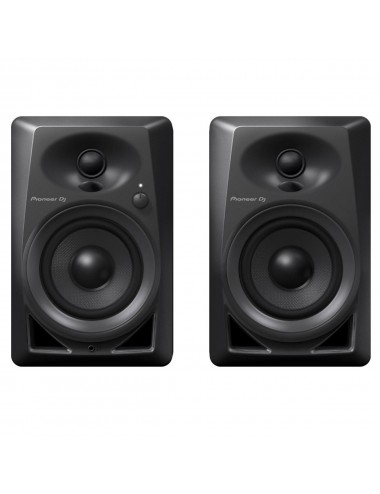
Kali IN-5 is one of the most innovative monitos studios ever made. Combining the natural advantages of a 3D design with a surreal display of a coaxial mid-range and twitter, it offers more transparency, lower distortion and a soundstage that must be heard to be believed.
Power. Detail. Soundstage.
The IN-5 Studio Monitor is a speaker like no other. Using the same woofer and tweeter from Kali's famous LP-8, the IN-5 adds a medium-diameter guide that surrounds the tweeter and acts as its waveguide.
This way, both the tweeter and the woofer are stocked. with less workload, are able to play cleaner and with less distortion.
The coaxial nature of the medium and the twitter make the IN-5 a source of acoustic point. This eliminates the deviation from the pod axis, resulting in a stereo sound stage that presents the listener with a super-realistic level of detail.
All of this means that the IN-5 is extremely accurate and easy to mix, and that the mixes made in the IN-5 will be wonderfully transferred to other systems.
IMAGING
We know. We continue to talk about the "surreal" depiction of IN-5. What does this mean?
When you listen to a stereo speaker set, you hear information about where the instruments and players were placed when the material was recorded. Even with purely digital material, producers can manipulate the physical locations of the elements in the mix, and you will hear them in a stereo recording.
Not only does this allow producers to create interesting spatial effects, but it also means you can work faster and with more confidence. A precise audio track lets you see every element of the mix in front of you, so you can hear exactly what happens when you make changes.
2-way systems with good waveguides, such as Kali's LP-6 and LP-8, do a good job of transmitting this spatial information. However, because the tweeters and woofers on these speakers (and most studio monitors!) Are separate, this information is lost in the space just above and below the speaker. This means that in the listening position, you do not hear the full stereo image.
IN-5 solves this problem. The tweeter and the middle section share an audio center and the woofer traverses 330 Hz, so the distance between the woofer and the medium size is much less than a quarter of the wavelength at the junction. This means that the IN-5 is an acoustic point source. Therefore, it has the same excellent directionality that the LP-6 and LP-8 have on their sides at a full 360 degrees around the speaker. You listen to all the space information in the listening position, so the sound scene you hear will have every detail in the mix.
CLARITY
The total harmonic distortion of the IN-5 is less than 1.4%, which is excellent. This is the result of unloading both the woofer and the tweeter, so that both do less work. The woofer penetrates at 330 Hz, 2.5 octaves lower than the LP-8.
Twitter traverses at 3000 Hz, almost an octave higher than the LP-8. Take up space between the hero of the IN-5 system: the 4-inch, optimized mid-profile driver profile. This guide has a lot of work to do. In addition to playing medium frequencies, it also acts as a waveguide for Twitter. This means that the shape must be precisely constructed to provide an ideal dispersion characteristic of Twitter.
It also means that the medium intervals must remain stationary. In many other coaxial or concentric systems, the large deviation from the larger guide causes a distortion of the shaft and degrades the accuracy of the system. The midline in the IN-5 is limited to a peak deflection of less than 1 millimeter, making the headset stagnant while still providing midrange to keep up with the powerful woofer and tweeter.
EASY USE
Limit EQ check
The given speaker position in a room can drastically change the frequency response. A speaker mounted against a wall or desk will sound very different from a speaker mounted on a stand, even in a well-crafted space. Hard surfaces such as walls, desktops, and recording consoles can alter the screen's low-frequency response and degrade overall sound clarity.
Fortunately, most of the common positions are quite predictable and easily corrected.
Kali's team did the Boundary EQ tuning at The Village Studios in Los Angeles and found EQ settings for offsetting to help you get the perfect sound for where to place your speakers.
Combined with the LF and HF fins, this will ensure that the speakers sound better, regardless of the room in which you mix or where the speakers are placed.
Characteristics:
Active: Yes
Amp Class: D
Config: Tri-Amped
LF power: 80 W
Mid-Range Power: 40 W
HF power: 40 W
Total power: 160 W
LF Driver: Woofer 5 ″ Multi-coated paper
Mid-Range Driver: 4 ″ Highly coated paper
HF guide: 1 ″ soft dome Tweeter
Frequency Response (-10 dB): 37Hz - 25kHz
Frequency range (± 3 dB): 45Hz - 21kHz
LF to Mid-Range Crossover: 280 Hz
Mid-Range to HF Crossover: 2800 Hz
Listening distance: 2.2 meters
Maximum SPL: 115 dB
Dimensions:
Height: 15.1 inches (38.2 cm)
Width: 8.2 inches (20.6 cm)
Depth: 11.2 inches (28.2 cm)
Weight: 19 pounds (8.43 kg)

























































Product Comments
Your review appreciation cannot be sent
Report comment
Report sent
Your report cannot be sent